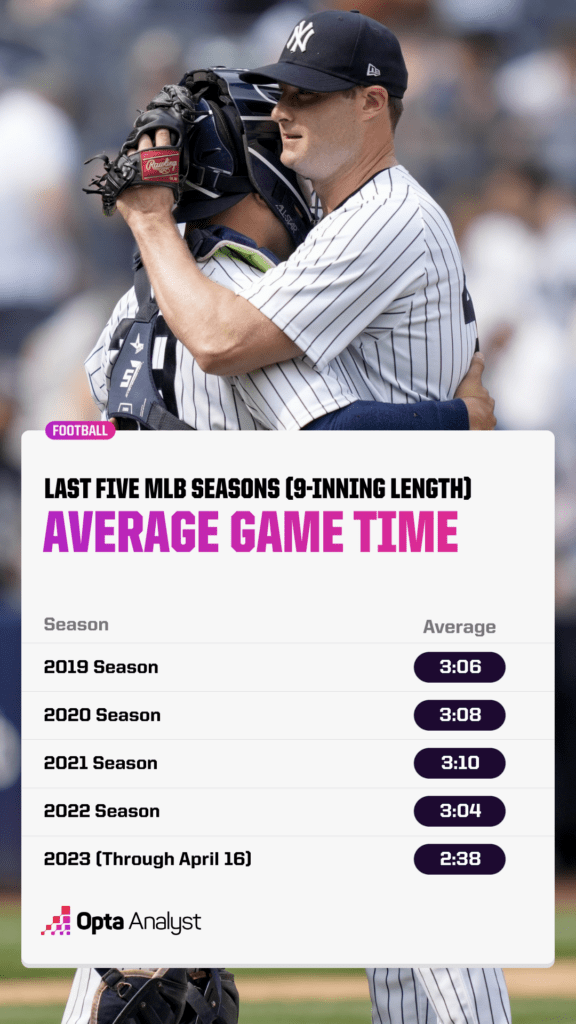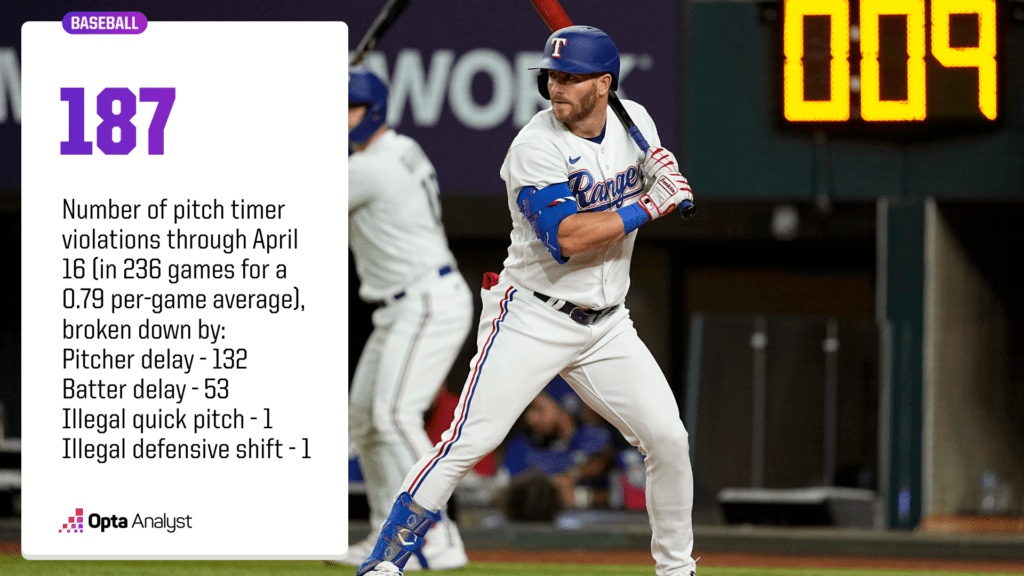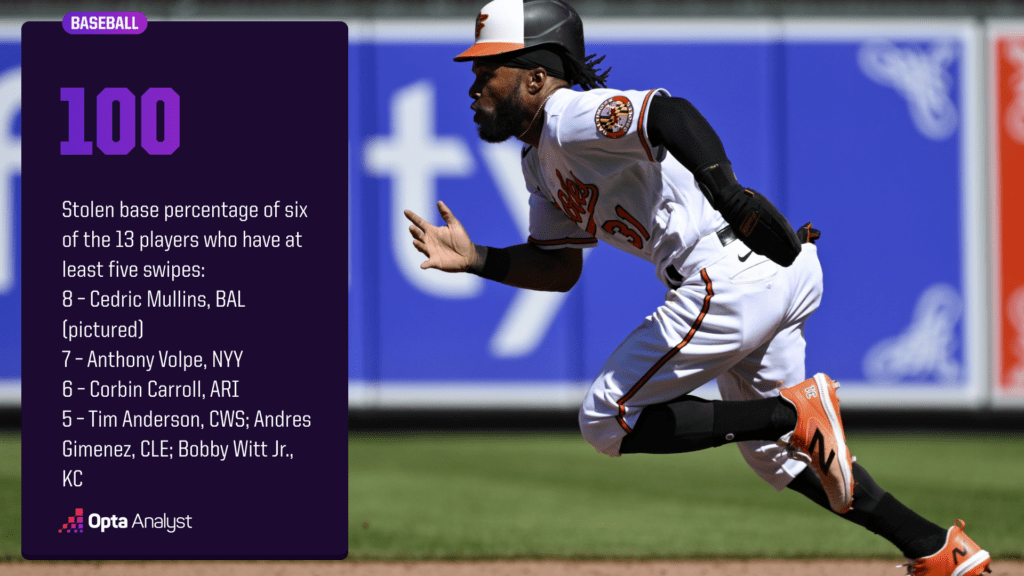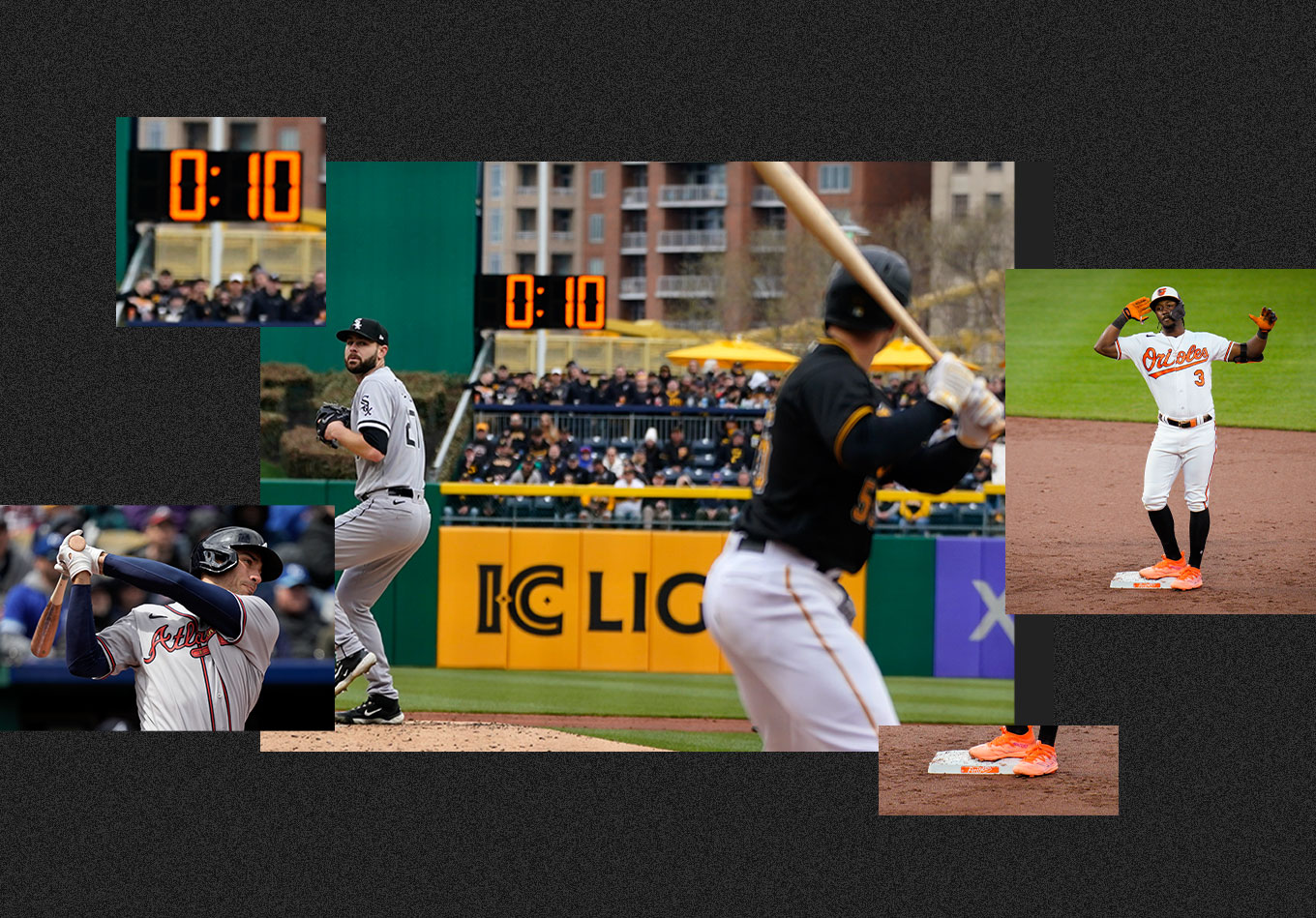Quite simply, the game is widely considered to be improved.
The three major rule changes that were implemented prior to the 2023 MLB season – a pitch timer, a limit on infield defensive shifts and bigger bases – have been generally embraced due to the way they have increased the pace of play and offense.
There’s more action in less time, with the length of games through Sunday (236 overall) averaging 2 hours, 38 minutes – down 26 minutes from last year (3:04) and 32 from 2021 (3:10), which was the slowest season to date.
The faster games mirror what has occurred in the minor leagues, where the three rules were experimented with previously.

As MLB teams continue to learn how the rules are changing the game, we’re diving into the numbers to see how they are affecting hitters, pitchers and defenses.
The Pitch Timer
Days of a pitcher walking off the mound between pitches or Mike Hargrove at the plate creating the “Human Rain Delay” are in the rear-view mirror.
Players have 30 seconds to resume play between batters, then it switches to 15 seconds between pitches with nobody on base and 20 seconds if there is a baserunner. A batter must be in the box and alert to the pitcher with eight seconds remaining on the clock, and he can call a timeout once per plate appearance.
A batter is penalized with an automatic strike if he isn’t ready in time for the pitch. A pitcher is given an automatic ball if he doesn’t deliver his throw in time.

There have been 187 pitch-timer violations through the first 236 games, but the early season results appear as much anecdotal as they are exact.
They may explain how some pitchers who are historically fast between pitches are off to solid starts this season, such as an ace like the Cleveland Guardians’ Shane Bieber (1-0, 2.88 ERA in four starts) or a surprise like the Milwaukee Brewers’ Wade Miley (2-1, 1.50 ERA), or high-profile pitchers who prefer to take their time between pitches have been subpar when compared to last season, such as the Philadelphia Phillies’ Aaron Nola (1-2, 5.91 ERA, 8.02 K/9 innings lowest since 2015), Toronto Blue Jays’ Alek Manoah (1-1, 6.98 ERA, 15 walks in 19.1 innings) and San Diego Padres’ Blake Snell (0-2, 6.92 ERA).
Conversely, the faster pace surely is to the liking of such fast-working batters as the Atlanta Braves’ Orlando Arcia (.333 BA, .911 OPS before going on the injured list) and the Cincinnati Reds’ Jonathan India (.333/.424/.500 slash line), who ranked first and third, respectively, in 2022 bases-empty tempo, according to MLB’s Baseball Savant. And not so much for a patient hitter such as the New York Mets’ Mark Canha (.192/.306/.385).
The number of pitchers with innings of 30 or more pitches has increased to 128 through the 236 games as compared to 113 through a comparable date last season, April 24 (237 games), when the season began a week later. With the pitch clock allowing less time, pitchers aren’t afforded the luxury of walking off the mound to compose themselves. (Manoah needed 42 pitches to get through the second inning against the Detroit Tigers on April 11 – an MLB season high to date.)
There’s a limit of two disengagements from the pitching rubber during a plate appearance – either to call timeout or attempt a pickoff throw.
The Limit on Shifts
Prior to this season, the increase of infield defensive shifts – usually with three infielders on one side of second base to defend pull hitters – grew rapidly in the last decade, from 4.1% of plate appearances in 2013 to an all-time high 31.4% last season.
Under the 2023 rules, two infielders must be on each side of second base when a pitch is delivered, and all four infielders must have both feet within the outer boundary of the infield.
Not surprisingly, league-wide averages are up from last season in batting average on balls in play – from .290 to .299 – and runs per game by team – from 4.28 to 4.66.
Among the five players with the most hits lost due to infield shifts from 2020-22, three quickly liked the more open space. The Texas Rangers’ Corey Seager, who had been robbed of 58 hits – the highest total – was off to a .359 batting average through 39 at-bats before he was sidelined by an injury.
He batted just .245 last year.
Matt Olson of the Braves is hitting at a .313 clip, up from .240 last year, and the Houston Astros’ Kyle Tucker is up from .257 to .302. Tucker’s teammate Yordan Alvarez also was particularly affected by infield shifts in recent seasons, with the Astros robbed of an MLB-high 232 hits from 2020-22.
San Francisco Giants opening-day starter Logan Webb, who had the second-most hits prevented over those three seasons, isn’t quite finding the same impressive numbers of his 2022 campaign, going 0-3 with a 4.76 ERA to open this season.
The Bigger Bases
While the lack of infield shifts has increased athleticism on defense, the bigger bases have made that aspect of the game even more evident with baserunners stealing bases.
The increase of bases from 15-square inches to 18 was enacted more to decrease collisions, but it has created a bit of a track meet after years of declining stolen base totals. The changes make both corner bases 4.5 inches closer to second base.
This year’s stolen base attempts and success rate are way up (346 for 419, or 82.6%) from last year’s similar season-opening period (227 for 308, or 73.7%).
Baltimore Orioles teammates Jorge Mateo and Cedric Mullins lead the AL and Nico Hoerner of the Chicago Cubs tops the NL with eight stolen bases each.

Among catchers, only four are above 50% in defending steal attempts: the Cubs’ Yan Gomes (2 of 2, 100%), the Diamondbacks’ Gabriel Moreno (4 of 6, 66.7%), the Boston Red Sox’s Connor Wong (4 of 6, 66.7%) and the Colorado Rockies’ Elias Diaz (3 of 5, 60%).
Phillies backstop J.T. Realmuto has thrown out the most base stealers, five, but it has come in 17 attempts.
All catchers are facing a tougher time at throwing out runners, and it’s not just because of the bigger bases. The fewer pickoff attempts and infielders playing farther away from bases due to the lack of shifts are aiding runners with their leads and, ultimately, success on steals.
It’s all working together to change the game. For the better, many say.
U.S. Data Insights senior editor Chase Weight of Stats Perform contributed research.
